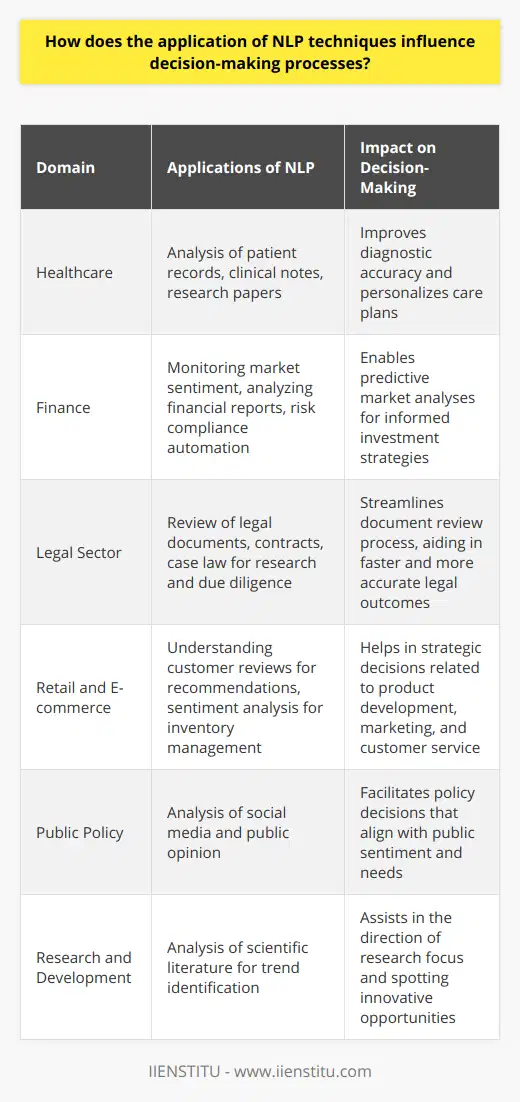
Neuro-linguistic programming, or NLP, is a set of techniques that can be used to persuade and influence people. The basic premise of NLP is that the way we think and communicate affects our behavior. Therefore, changing how we feel and sound can change our behavior. This can be useful in persuading people to do something, such as buying a product or signing up for a service. Many different techniques fall under the umbrella of NLP, but some of the most common include mirroring, matching, and pacing. When used correctly, these techniques can help you build rapport with someone, establish trust, and ultimately get them to do what you want.
Is it possible to persuade with NLP?
If you want to persuade someone with NLP, it is essential to understand their needs and wants. Once you know what they want, you can use NLP techniques to help them see how your proposal meets their needs. When done correctly, NLP can be a potent tool for persuasion. However, it is essential to remember that NLP is not a magic bullet. It is simply a set of techniques that, when used correctly, can be very effective.
The three basic principles of NLP
The three basic principles of NLP are simple but powerful. First, if you want to change your behavior, you need to start by changing your thoughts. This is because the way we think affects the way we behave. We can change our thoughts by changing the way we communicate. For example, if we want to persuade someone to do something, we must first convince them that it is a good idea. We can do this by using positive language and ensuring that our body language is congruent with what we are saying. If we want to change our behavior, we need to change our thoughts first. This is because the way we think affects the way we behave. We can change our beliefs by changing the way we communicate. For example, if we want to persuade someone to do something, we need first to convince them that it is a good idea. We can do this by using positive language and ensuring that our body language is congruent with what we are saying. The third principle is that how we communicate affects how we think and behave. This means that if we want to change our behavior, we need first to change how we communicate. For example, if we're going to persuade someone to do something, we need to use positive and empowering language. We also need to make sure that our body language is congruent with what we say. If you want to change your behavior, you need to start by changing your thoughts. This is because the way we think affects the way we behave. Finally, we can change our thoughts by changing the way we communicate. For example, if we want to persuade someone to do something, we must first convince them that it is a good idea. We can do this by using positive language and ensuring that our body language is congruent with what we are saying.
How to use NLP techniques to persuade people
NLP, or Neuro-Linguistic Programming, is a set of techniques that can be used to influence the behavior of others. While NLP can be used for various purposes, it is often used as a tool for persuasion. Some of the most common NLP techniques used for influence include mirroring, matching, and pacing.
Mirroring is a technique in matching the other person's body language, voice tone, and words. This creates rapport and makes the other person feel like you are similar to them.
Matching is a technique to match the other person's body language, voice tone, and words. This creates rapport and makes the other person feel like you are similar to them.
Pacing is a technique in which you lead the other person by matching their body language, voice tone, and words. This makes them feel like you understand them and increases the likelihood that they will follow your lead.
Each of these techniques can effectively persuade others, but it is essential to use them wisely. Overusing or misusing these techniques can result in the opposite effect — causing the other person to feel uncomfortable or threatened. When
Examples of how to use NLP in real-life situations
Here are some examples of how you could use NLP in real-life situations:
If you want to convince your friend to try a new restaurant, you could use NLP techniques to create a compelling argument. For example, you could start by finding out what kind of foods they like and then persuade them that the new restaurant has dishes they will love.
If you want to convince your boss to give you a raise, you could use NLP techniques to show them how much value you bring to the company. You could start by highlighting your key accomplishments and then linking those accomplishments to the company's bottom line.
If you want to get a stranger's phone number, you could use NLP techniques to build rapport and connect with them. You could start by making small talk and then find common ground to use as a basis for further conversation.
If you want to persuade a salesperson to give you a discount, you could use NLP techniques to show them that you are a valuable customer. For example, you could start by showing them how much money you have spent at their store in the past and then asking for a discount on your current purchase.
There are many benefits to using NLP techniques for persuasion. Some of the most common include
NLP, or Neuro-Linguistic Programming, is a set of techniques that can be used to improve communication and persuasion skills. NLP can be an invaluable tool for getting what you want in both business and personal interactions when used correctly. One of the most appealing aspects of NLP is that it can be used in various situations. Whether you're trying to close a business deal or win over a new romantic partner, NLP can help you achieve your goals. However, it's important to remember that NLP is a powerful tool, and, like all tools, it can be misused. Some of the potential risks associated with using NLP include:
Building rapport too quickly: If you build rapport with someone too quickly, they may feel uncomfortable or threatened. Rapport should be built slowly and carefully to create a trusting relationship.
Establishing trust inappropriately: It's important to only establish trust with people who deserve it. If you trust someone who doesn't deserve it, they may take advantage of you or even hurt you.
Creating dependency: If you use NLP techniques to get what you want from someone, they may become dependent on you. This can be a good thing if you want to create a long-term relationship, but it can be bad if you only want something from them in the short term.
Crossing ethical boundaries: NLP techniques can be used for both good and evil. If you use NLP techniques to hurt or manipulate someone, you may be crossing ethical boundaries.
There are some potential risks associated with using NLP techniques. These risks include
NLP, or Neuro-Linguistic Programming, is a set of techniques that can be used to influence and persuade other people. When used correctly, NLP can be a powerful tool for persuasion. However, there are also some potential risks associated with using NLP techniques. These risks include:
NLP techniques can be misused to manipulate people
If not used correctly, NLP techniques can backfire
NLP techniques should not be used on vulnerable people
Before using NLP techniques to persuade someone, weighing the risks and benefits is essential. If you decide to use NLP, be sure to do so with care and respect for the other person.
NLP is a powerful tool that can persuade people in a variety of real-life situations. The three basic principles of NLP are rapport, pacing, leading, and mirroring and matching. By using these principles, you can create a connection with the person you are trying to persuade and influence their behavior. There are many benefits to using NLP techniques for persuasions, such as increased sales, improved communication skills, and better relationships. However, it is essential to note that potential risks are also associated with using NLP. If you are interested in learning more about using NLP for persuasion, please consider enrolling in our online NLP course.
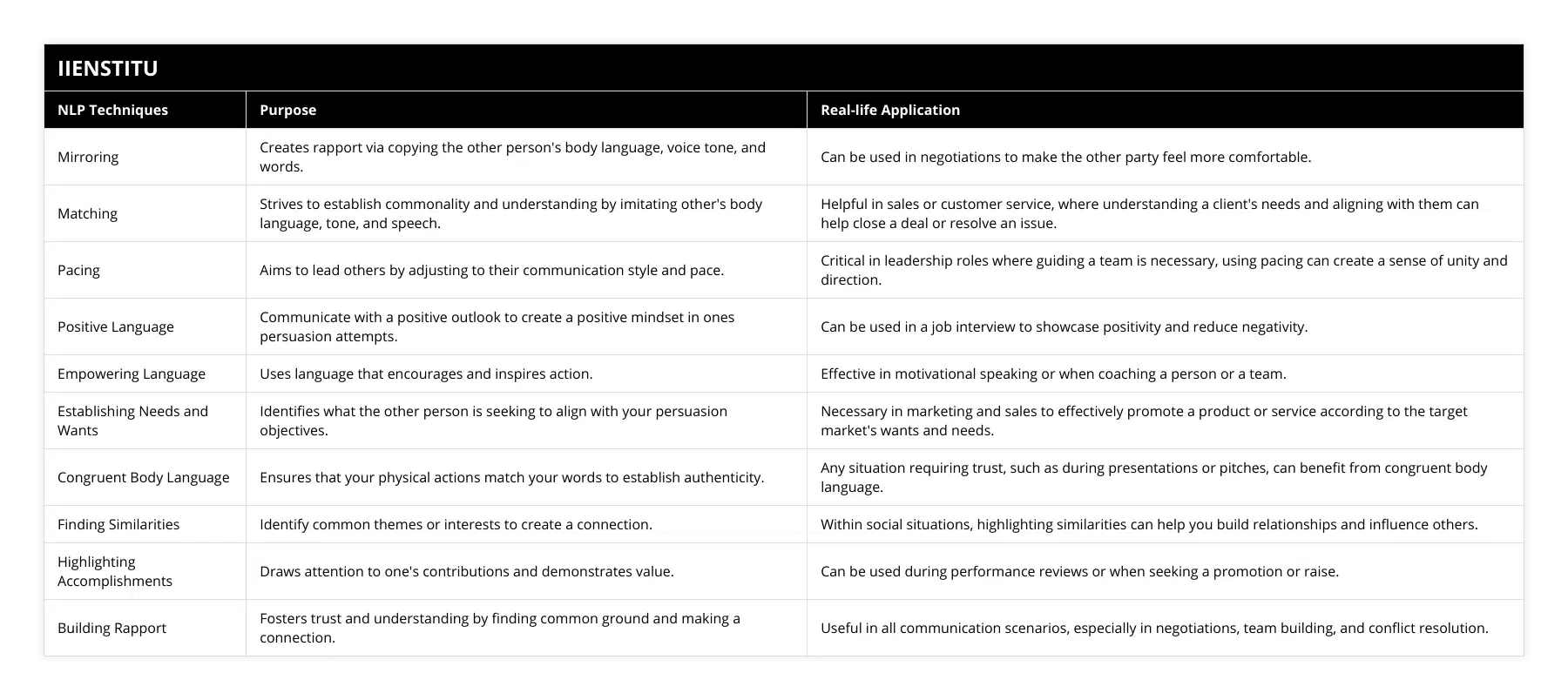
Frequently Asked Questions
How can NLP be used to persuade people?
NLP can be used to persuade people in a variety of ways. For instance, NLP can be used to create rapport with someone by matching their body language and vocal patterns. NLP can also be used to reframe questions or statements in a way that is more likely to get the person to agree with you. For example, instead of asking -Do you want to go for a walk?”-you could say -Would you like to get some exercise?-
What are some of the most common techniques used in NLP?
There are a number of different techniques that can be used in NLP. Some of the most common techniques include:
Anchoring - This involves creating a physical or emotional response to a particular stimulus. For example, you might associate a feeling of happiness with the sound of a bell ringing.
Chunking - This is the process of breaking down information into manageable chunks. This can be helpful for learning new material or for improving memory recall.
Collapsing - This is the process of reducing resistance and increasing compliance by removing objections from someone's mind. It can be used, for example, to get someone to agree to do something they might otherwise not want to do.
Is NLP a reliable method for persuasion?
Yes, NLP is a very reliable method for persuasion. There are many studies that have shown that NLP is highly effective in persuading people to change their opinions and behaviors. For example, one study found that NLP was able to increase the likelihood of convincing people to vote by 7%.
NLP works by exploiting the way our brains process information. It uses certain language patterns and tricks to bypass our logical reasoning and appeal directly to our emotions. This makes NLP very powerful, but also very dangerous if it falls into the wrong hands.
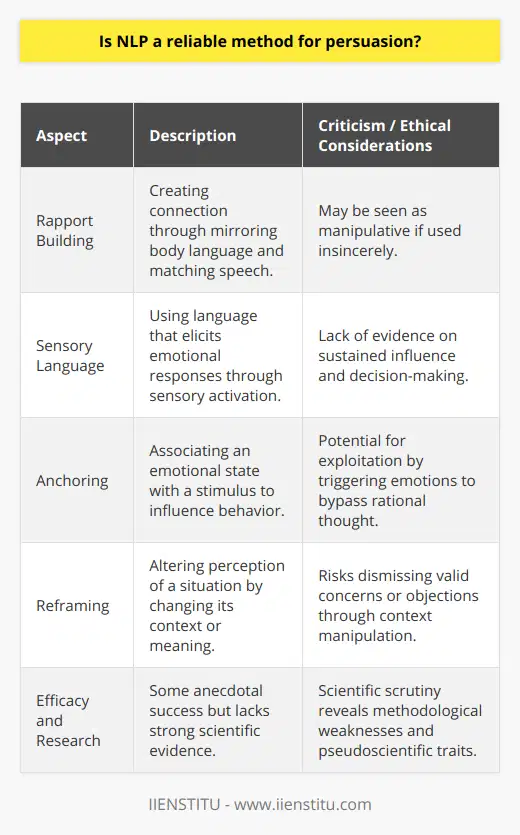
Can you use NLP to manipulate?
NLP as a Tool for Manipulation
Undeniably, individuals can employ Natural Language Processing (NLP) as a means to manipulate. NLP, which refers to the intersection of artificial intelligence and linguistics, works to break down the process of understanding and generating human language. Proficient NLP practitioners possess the skillset to influence opinions, emotions and behaviors. Consequently, this expertise might contribute to intentional manipulation.
Techniques Utilized in NLP
In NLP, various techniques can facilitate manipulation, including subliminal messaging, embedded commands, and suggestive language. Subliminal messaging targets an individual's unconscious mind to plant ideas, beliefs, or emotions. Embedded commands, on the other hand, are devised to direct the listener's attention towards specific outcomes. Lastly, the application of suggestive language enables NLP practitioners to bypass a person's logical reasoning and persuade them without much resistance.
NLP in Marketing and Sales
The marketing and sales sectors have notably benefited from the persuasive aspect of NLP to manipulate customer decisions. Advertisers often harness the power of NLP to create influential marketing campaigns that resonate with consumer emotions and present hidden messages, nudging people towards purchasing products or services. Sales representatives, too, frequently adopt NLP techniques to establish rapport and better understand customer needs, thereby striking profitable deals.
Concerns about Ethical Boundaries
Given NLP's manipulative potential, it is crucial to acknowledge ethical concerns associated with its applications. Practitioners should always strive to maintain a balance between using NLP to improve communication and misusing it to exploit others. Ethics must be at the forefront while employing NLP, and practitioners should adhere to a code of conduct that ensures responsible use of such powerful communication tools.
In conclusion, NLP indeed has the capacity for manipulation when used inappropriately. The onus, therefore, lies upon the practitioners to harness NLP techniques conscientiously to promote ethical and constructive communication.
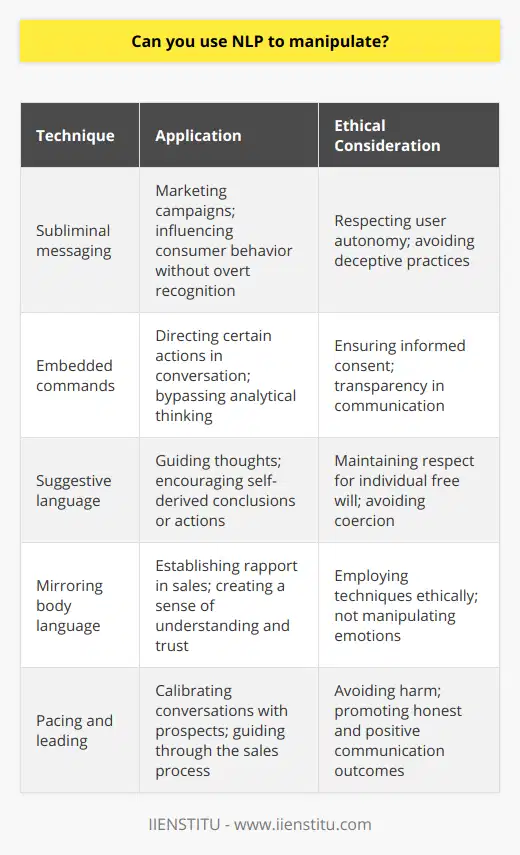
How do you use NLP for effective decision-making?
Utilizing NLP in Decision-Making Processes
Natural Language Processing (NLP) is a sub-discipline of Artificial Intelligence (AI) that focuses on enabling computers to comprehend, interpret, and generate human language. Employing NLP in decision-making can enhance the effectiveness of the process in various ways.
Data Analysis and Interpretation
Firstly, NLP can be used to analyze and interpret large volumes of unstructured text data, such as customer reviews, social media posts, news articles, and internal communications. It can identify patterns, trends, and relevant insights, empowering decision-makers to make informed decisions based on this valuable information.
Sentiment Analysis
Another application of NLP is sentiment analysis, which involves detecting and categorizing opinions expressed in textual data. By understanding the sentiment behind the text, businesses can gain insights into public opinion and customer emotions. This, in turn, can inform marketing strategies, product development, and customer service improvements.
Information Extraction
NLP can also aid decision-making by extracting specific pieces of information from text data. This includes identifying names, dates, locations, and other crucial details that can influence a decision. For instance, NLP can help organizations track competitors by automatically extracting relevant data from news articles, press releases, and other public information sources.
Machine Translation
Moreover, global organizations can utilize NLP for machine translation and cross-language information retrieval. This allows decision-makers to access and process information in various languages, ensuring inclusive and well-informed decision-making processes.
Automated Summarization
Lastly, NLP can help decision-makers cope with information overload by generating concise summaries of large documents or datasets. It is particularly useful when stakeholders need to review substantial amounts of information in a limited timeframe, assisting them in grasping key points quickly and efficiently.
In conclusion, employing NLP in decision-making processes can significantly enhance their effectiveness by facilitating data analysis, sentiment analysis, information extraction, machine translation, and automated summarization. By enabling more informed and timely decisions, NLP can enhance the overall performance and strategic capabilities of organizations across various industries.
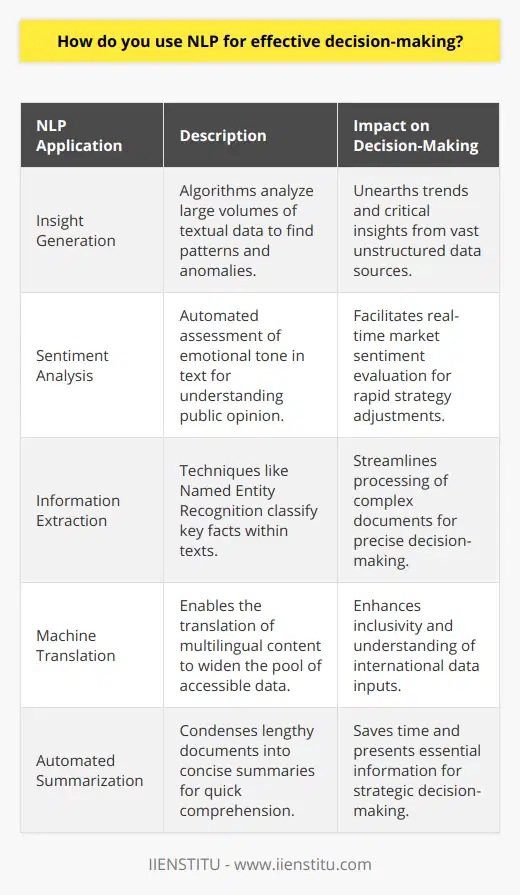
What are five NLP tactics for successful negotiation?
Effective Communication Skills
One crucial NLP tactic for successful negotiation is mastering effective communication skills. NLP tools such as rapport building, active listening, and the use of powerful language patterns enable negotiators to create trust, reduce misunderstanding, and communicate persuasively.
Rapport Building
Establishing rapport is essential for effective negotiation, as it allows parties to feel connected and open to collaboration. NLP techniques such as mirroring, matching, and pacing can be employed to establish and maintain rapport, making it easier to reach an agreement.
Reframing Perceptions
Another NLP tactic for successful negotiation is reframing perceptions, which involves presenting information in a way that emphasizes the positive aspects of a situation. This technique can help to transform potential obstacles into opportunities, making the negotiation process more constructive and productive.
Managing Emotions
Emotional intelligence in negotiation is vital to achieving successful outcomes. NLP techniques such as anchoring and state management can be used to manage both the negotiator's own emotions and those of the other parties, helping to maintain a composed, focused, and collaborative atmosphere.
Creating Win-Win Outcomes
Finally, NLP tactics can be employed to facilitate the creation of win-win outcomes where both parties feel satisfied with the resolution. Techniques such as sensory acuity, reality testing, and the use of creative problem-solving strategies can help to identify underlying interests and achieve mutually beneficial results.
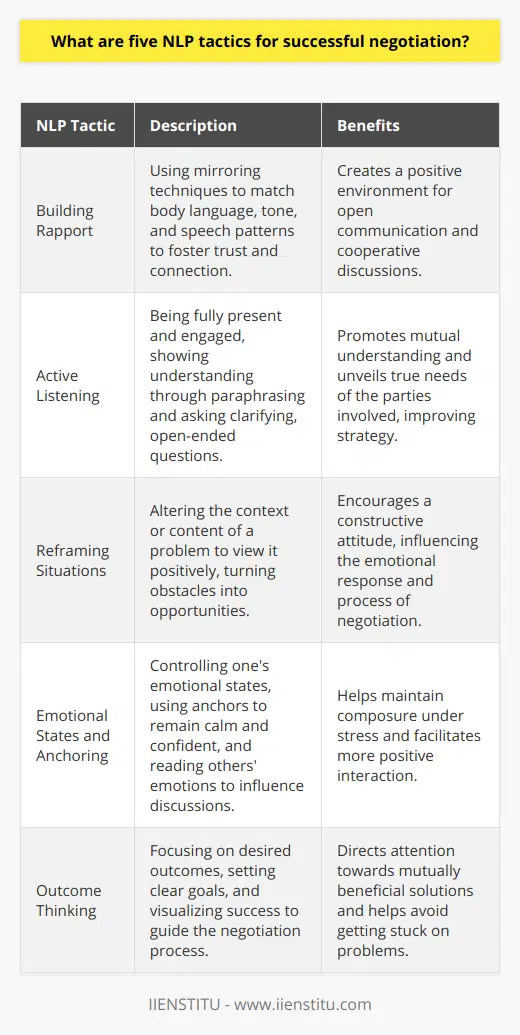
How can NLP enhance one's communication skills?
Role of NLP in Communication Enhancement
Natural Language Processing (NLP) has a profound impact on one's communication abilities by leveraging technology to analyze and understand human language. NLP enables users to communicate more effectively by addressing key areas such as clarity, coherence, and understanding.
Improvement of Clarity
NLP tools, such as grammar and spell checkers, aid individuals in crafting clearer, more concise messages. These tools enhance communication by identifying errors, suggesting improvements, and refining text, thereby reducing misunderstandings and increasing comprehension among the receivers of the message.
Ensuring Coherence
Semantic analysis, an integral component of NLP, examines the meaning of words and phrases in context. By evaluating textual content for coherence, NLP helps users to maintain consistency in their messaging and avoid ambiguity. This capability is crucial in avoiding misinterpretations and fostering better understanding between parties.
Enhancing Understanding
NLP technologies, such as machine translation, work to bridge language barriers and improve understanding in multilingual communication. By accurately translating content between languages, communication becomes more accessible, inclusive, and effective among various groups.
Promoting Active Listening
Sophisticated NLP technologies, such as voice assistants and transcription services, amplify active listening skills. Converting spoken language to written text enables users to review and analyze information more thoroughly, fostering deeper understanding and more effective communication.
Overall, by utilizing NLP technologies, individuals can significantly enhance their communication skills. These advancements foster clearer expression, promote better understanding among diverse groups, and contribute to more effective interaction, both personally and professionally.
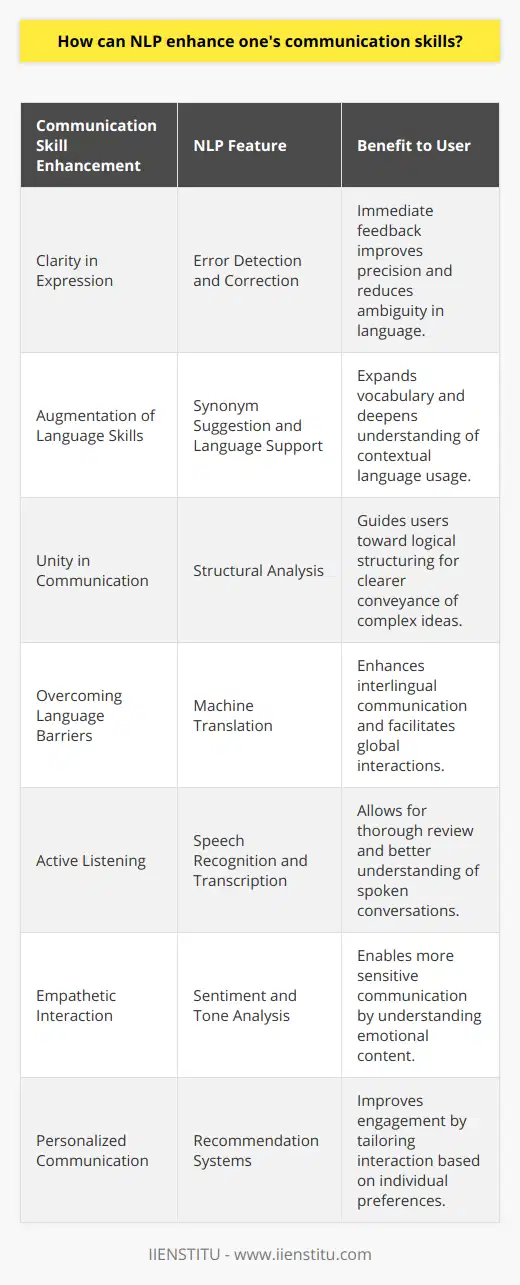
What is the role of NLP in personal and professional development?
Role of NLP in Personal Development
Natural Language Processing (NLP) plays a significant role in personal development, primarily by aiding in effective communication. Through understanding and interpreting human language, NLP allows individuals to better express their thoughts and emotions, leading to improved interpersonal relationships. Additionally, NLP techniques enable people to identify and modify their behaviors, beliefs, and thought patterns, thereby fostering personal growth and well-being.
Enhancing Emotional Intelligence
A crucial aspect of personal development is enhancing emotional intelligence, which involves understanding and managing one's emotions and the emotions of others. NLP can assist in this process by analyzing and processing emotional signals conveyed through text and speech. This empowers individuals to recognize and regulate their emotional responses, resulting in increased self-awareness and improved emotional management skills.
NLP in Professional Development
In professional contexts, NLP proves beneficial for career advancement and organizational success. By facilitating clear communication and minimizing misunderstandings, NLP techniques foster a positive and productive work environment. Moreover, NLP enables employees and leaders to develop critical soft skills, such as active listening, empathy, and persuasion, which are vital in today's dynamic workplace.
Impact on Decision-Making
NLP contributes to improved decision-making in professional settings by supplying data-driven insights. By analyzing and interpreting vast quantities of unstructured text data, NLP algorithms can extract valuable information, identify patterns, and make accurate predictions. Consequently, this enables organizations to make informed decisions, enhance strategic planning, and achieve optimal results.
Conclusion
In summary, NLP has a substantial impact on both personal and professional development by improving communication skills, fostering emotional intelligence, and facilitating data-driven decision-making. By harnessing the power of NLP, individuals and organizations can continually learn, grow, and adapt to the ever-changing demands of the modern world.
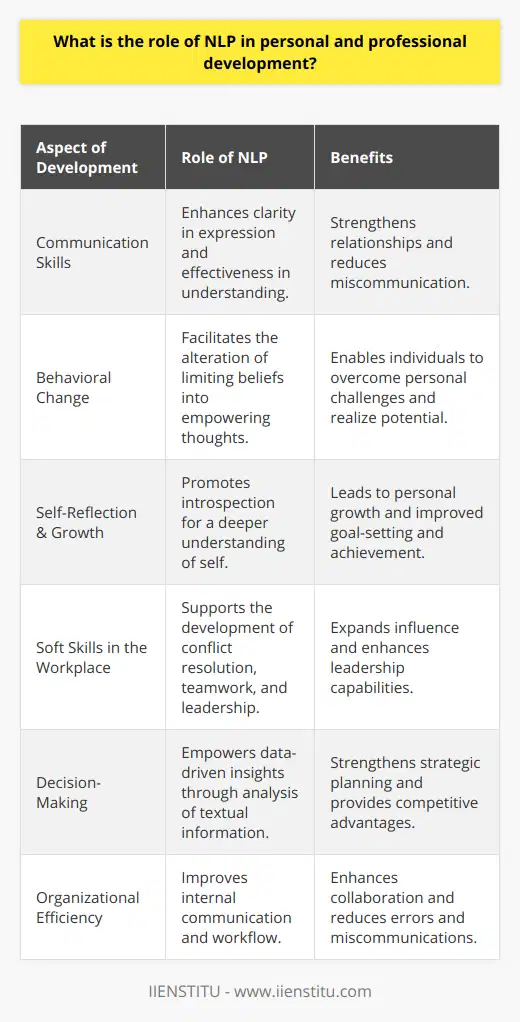
Can NLP be utilized for conflict resolution and mediation?
NLP Applications in Conflict Resolution
Undoubtedly, natural language processing (NLP) can be a valuable tool for conflict resolution and mediation. This branch of artificial intelligence (AI) aims to enable computers to understand, interpret, and generate human language in a way that is both meaningful and useful. By analyzing language patterns, NLP can provide insights into human behavior and motivations, which are crucial factors in successful conflict resolution.
Enhanced Communication
One of the key elements in mediation and conflict resolution is effective communication. NLP can facilitate this by identifying misunderstandings, clarifying intentions, and highlighting common ground between conflicting parties. Through sentiment analysis, which involves identifying and categorizing emotions in a text, NLP can help mediators understand the feelings behind the words used by the disputing parties. This can lead to more empathetic and targeted interventions.
Pattern Detection
NLP excels in identifying patterns and trends within large datasets. It can be used to analyze previous conflicts and resolutions, uncovering commonalities and developing best practices for approaching similar situations in the future. This can help mediators become more proficient in their work, leading to higher success rates in resolving disputes.
Language Generation
With advancements in NLP, AI systems are now capable of generating human-like text. This can be utilized to provide mediators with more effective language when communicating with parties in conflict. By employing tactful, persuasive, and empathic language, mediators can create an environment more conducive to finding a resolution.
Cultural Sensitivity
NLP can also be trained to understand different cultural contexts and adapt its analysis and language generation accordingly. This can prove essential in cross-cultural conflict resolution, where misunderstandings can often arise due to differences in communication styles, values, and expectations. By accounting for these cultural nuances, NLP can support mediators in navigating these complex situations more effectively.
Automated Mediation
Lastly, NLP could pave the way for automated mediation systems in certain low-stakes conflicts, such as disputes in online forums or customer complaints. AI-powered chatbots, equipped with NLP capabilities, can analyze text inputs, understand user concerns, and offer tailored responses to facilitate resolution.
In conclusion, the potential applications of NLP in conflict resolution and mediation are vast and varied. By providing insights into human behavior and enhancing communication, NLP can support mediators in their efforts to resolve disputes, ultimately leading to more effective interventions and successful outcomes.
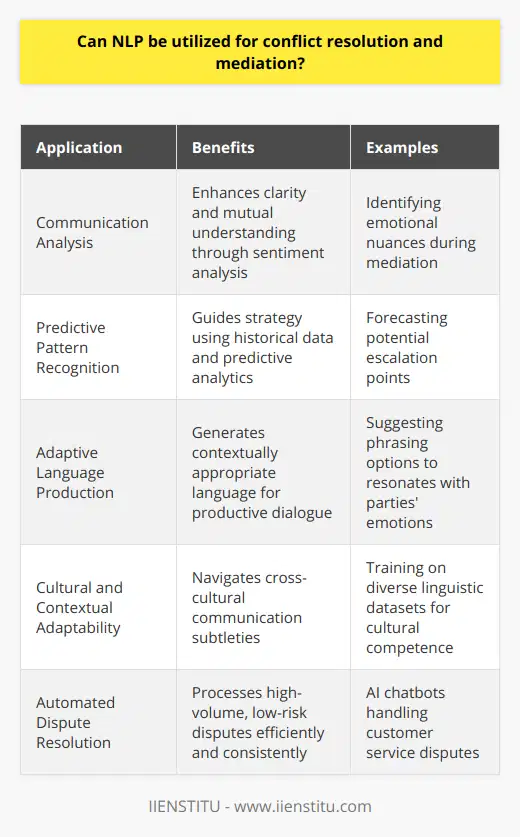
How can using NLP in conversations be a persuasive method?
NLP as a Persuasive Tool
One way utilizing natural language processing (NLP) in conversations can be a persuasive method is by enhancing the effectiveness of communication. NLP techniques help individuals understand and adapt to the linguistic patterns, emotional states, and thought processes of conversation partners, thereby fostering rapport and trust. Specifically, NLP enables persuasive communication by increasing empathy, precision, and relevance in the exchange of ideas and information.
Emphasizing Empathy
Employing NLP strategies in conversations encourages empathetic understanding, which is key to persuasion. By mirroring language, tone, pace, and body language, conversationalists can build rapport and demonstrate a genuine appreciation for the other person's perspective. This non-threatening approach lays the groundwork for effectively influencing others, as they feel heard and respected.
Precision in Language
NLP tools improve the clarity of communication, which is a crucial element in persuasive conversations. Accurate descriptions and clear questions help minimize misunderstandings and promote open dialogue. As a result, NLP practitioners can express their intentions and arguments more effectively, increasing the likelihood of convincing their conversation partners to adopt a certain viewpoint or take a particular course of action.
Relevance and Understanding
By using NLP techniques to uncover underlying beliefs and values, conversationalists can tailor their persuasive message to better resonate with their audience. Understanding the other person's mental, emotional, and motivational state contributes to effective persuasion. When the message is customized to accommodate individual perspectives, it can lead to agreement or at least thoughtful consideration of the proponent's position.
In conclusion, the application of NLP techniques in conversations can serve as a powerful method of persuasion. By fostering empathy, enhancing language precision, and addressing the unique perspectives of others, NLP practitioners create an environment for influential communication. Knowledge of NLP enhances the effectiveness of persuasive messaging, ultimately increasing the likelihood of achieving desired outcomes in conversations.
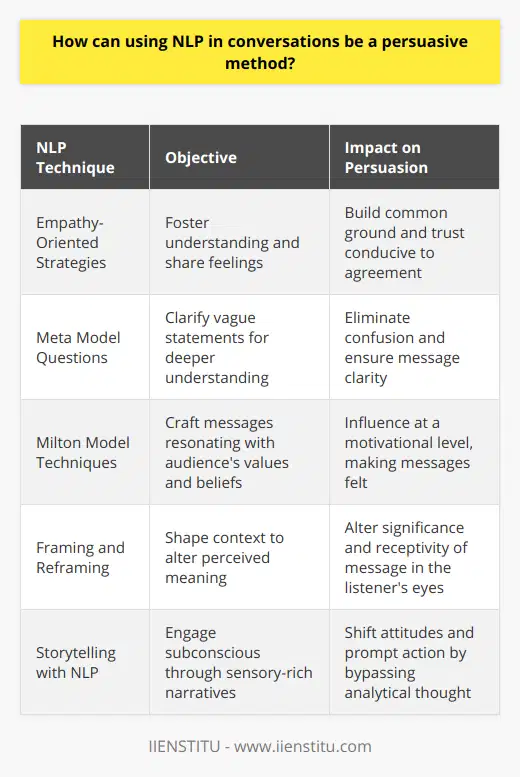
What are the key principles of NLP in enhancing interpersonal communication?
Understanding NLP Principles
The key principles of Neuro-Linguistic Programming (NLP) aid in enhancing interpersonal communication by focusing on aspects such as rapport building, sensory acuity, and matching communication styles.
Building Rapport
Rapport is the foundation for successful communication, enabling a deeper connection and increased trust between individuals. In NLP, rapport building involves mirroring and matching a conversation partner's body language, voice tone, and speaking patterns to establish a sense of familiarity and understanding. This principle facilitates smoother exchanges, as well as increased empathy and openness during interactions.
Sensory Acuity
Enhancing sensory acuity in interpersonal communication plays a crucial role in perceiving verbal and non-verbal cues from conversation partners. NLP emphasizes the importance of keen observation and fine-tuning individual senses to detect subtle shifts in body language, facial expressions, and voice tonality. Improved sensory acuity allows individuals to adapt their communication styles to better suit their partners, fostering more friendly and effective interactions.
Matching Communication Styles
NLP principles encourage individuals to identify and adopt their communication partner's preferred representation system - visual, auditory, or kinesthetic - to improve understanding and provide a highly personalized communication experience. By identifying these preferences and adjusting communication styles accordingly, individuals can cater to their partners' needs, ensuring improved clarity and enhanced comprehension of information being exchanged.
In conclusion, NLP's key principles provide valuable insights and techniques to elevate interpersonal communication and establish strong connections. By building rapport, increasing sensory acuity, and matching communication styles, individuals can cultivate meaningful and effective interactions with others.

How does the application of NLP techniques influence decision-making processes?
Application in Various Sectors
Natural Language Processing (NLP) techniques have a significant impact on decision-making processes across various sectors. By unlocking valuable insights from unstructured data, NLP tools enable organizations to make data-driven decisions with more accuracy and efficiency.
Automated Text Classification
With the increasing amount of textual data available, NLP-driven text classification helps automate the process of sorting information into predefined categories. This, in turn, facilitates informed decision-making by providing easy access to relevant information for various business functions.
Sentiment Analysis for Consumer Insights
NLP-powered sentiment analysis deciphers the emotions and opinions expressed by customers in their reviews, social media interactions, and emails. Extracting these sentiments enables businesses to understand their strengths and weaknesses, ultimately driving improved product offerings and customer experiences.
Contextual Chatbots and Conversational AI
Incorporating NLP capabilities into chatbots and conversational AI platforms empowers organizations to offer personalized and efficient customer service. As a result, companies can drive improved customer satisfaction and retention, which ultimately influences their decision-making regarding resource allocation and strategy development.
Semantic Analysis for Enhanced Decision-making
The application of NLP techniques allows businesses to extract meaningful patterns from vast sets of textual data. This semantic analysis facilitates better comprehension of complex information, thereby enabling relevant stakeholders to make informed decisions based on accurate data-driven insights.
In conclusion, the integration of NLP techniques into decision-making processes offers businesses increased efficiency, accuracy, and relevancy when navigating vast amounts of textual information. By automating key functions and unveiling data-driven insights, organizations can make well-informed decisions that contribute to their overall growth and success.
